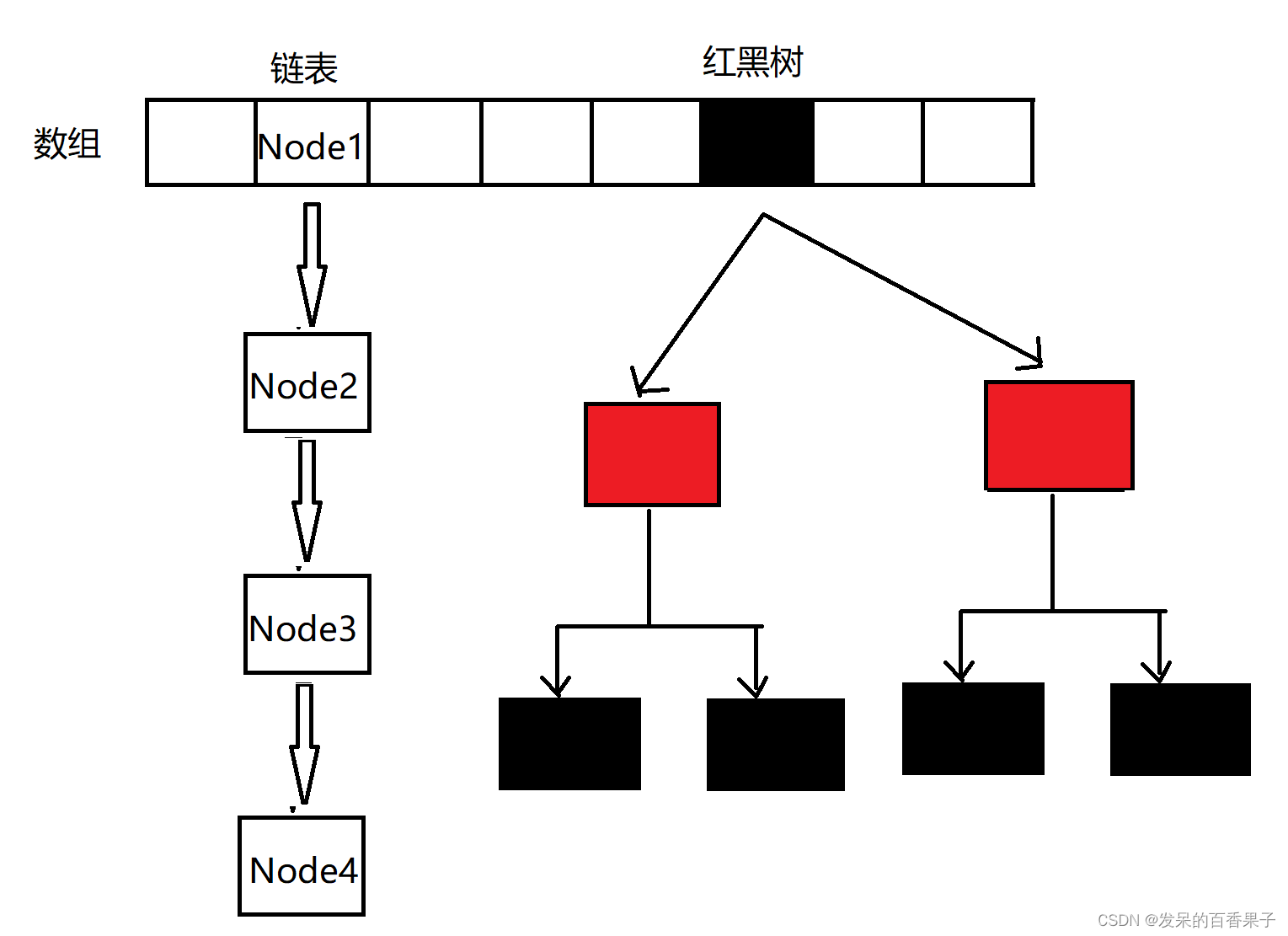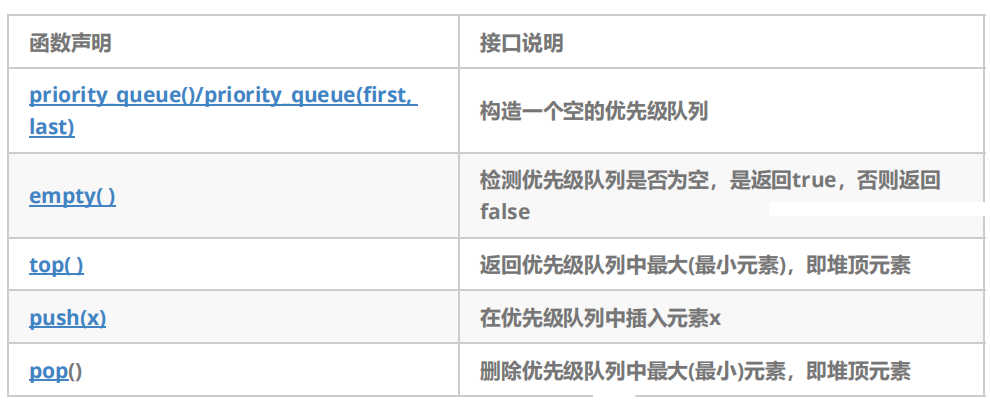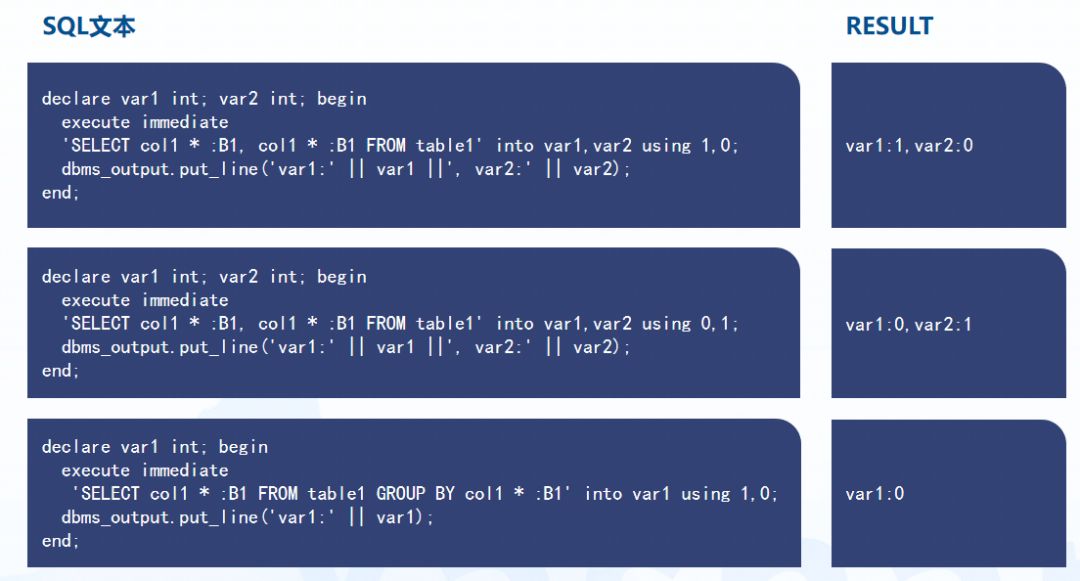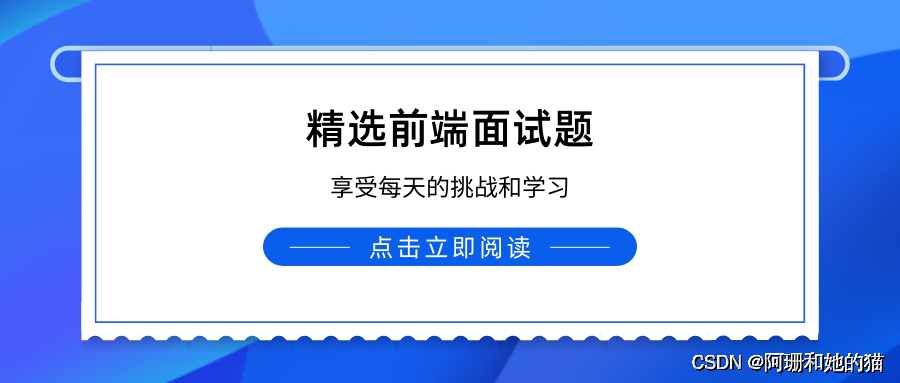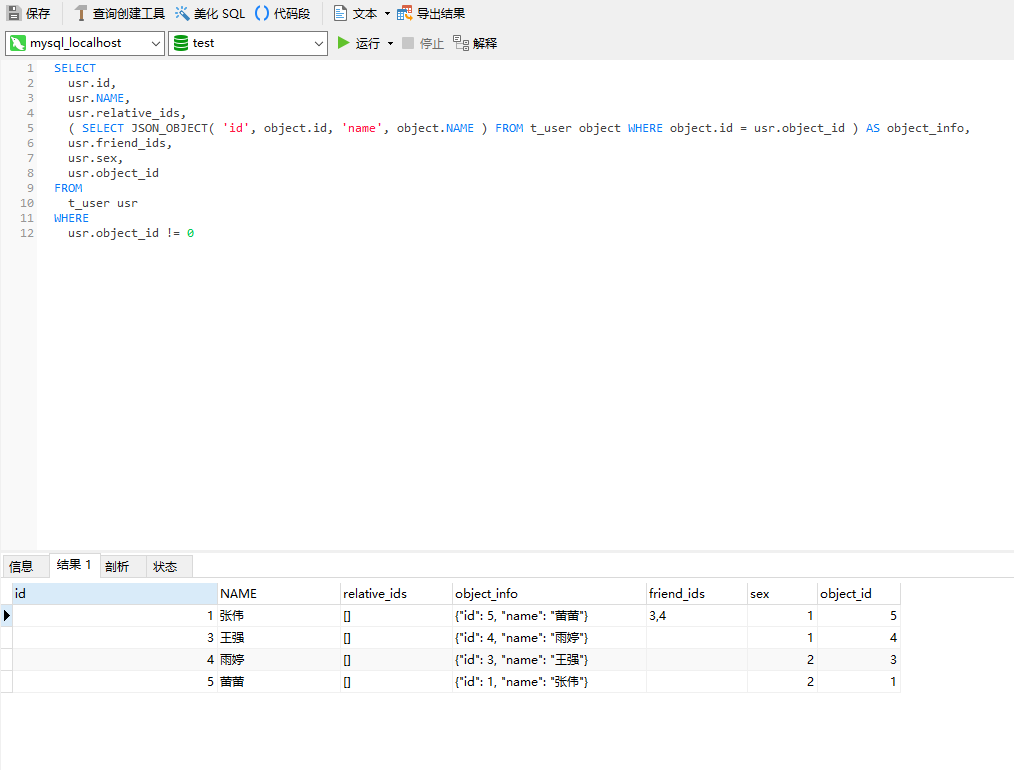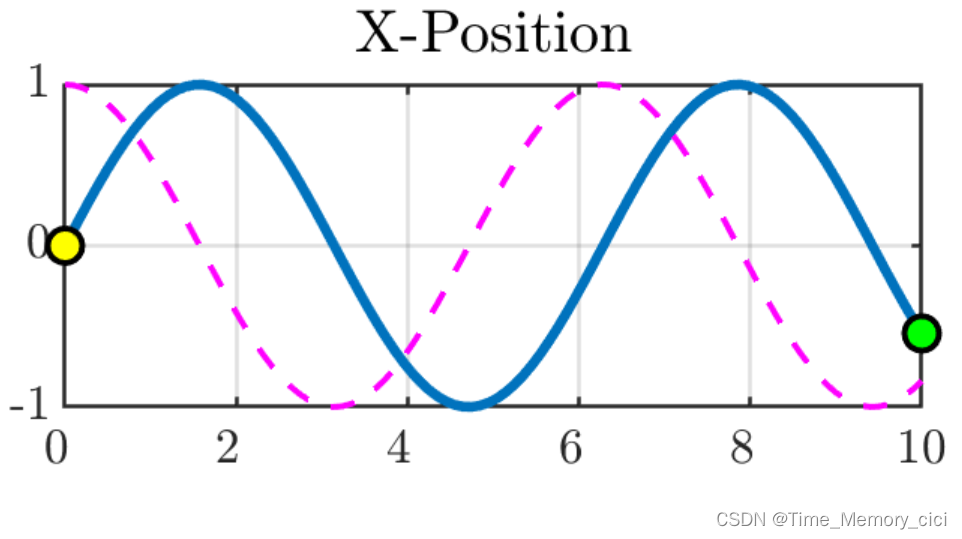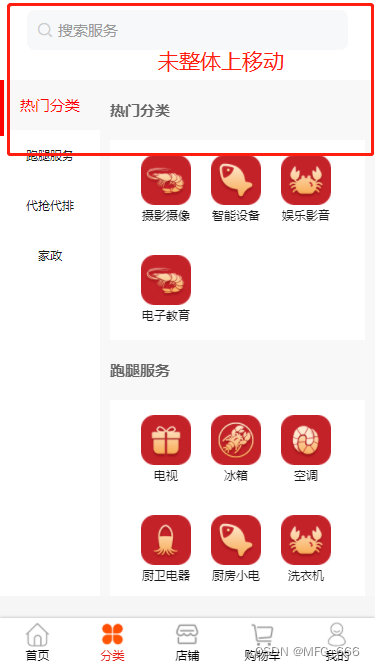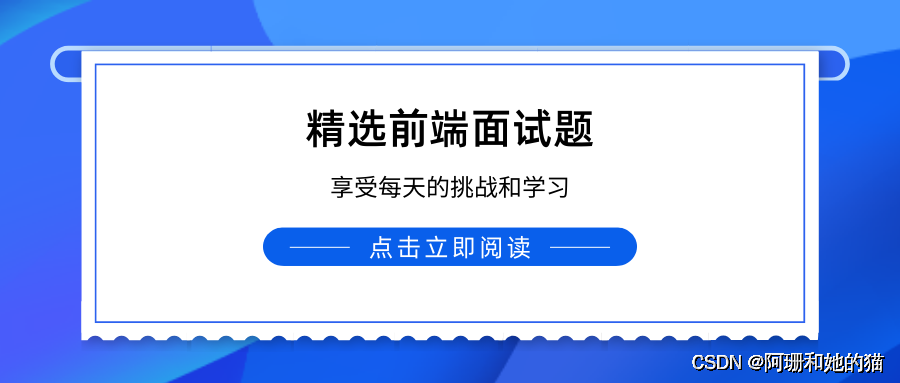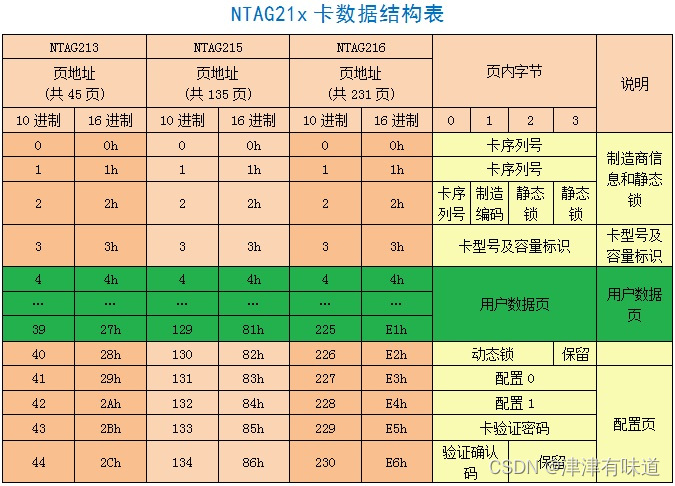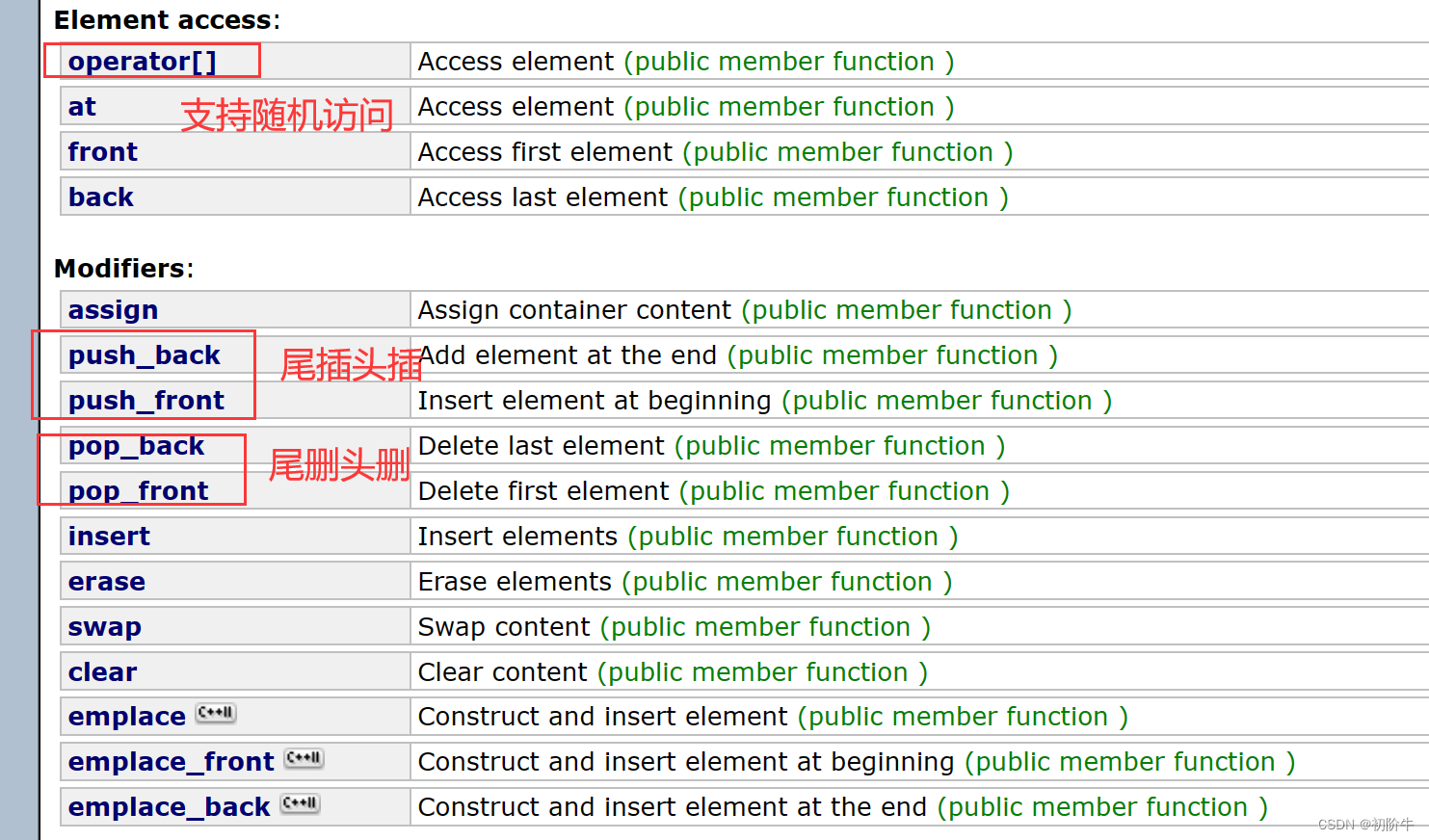目录
一、Arraylist的缺陷
二、链表
2.1 链表的概念和结构
2.2 链表的实现
三、链表面试题
3.1 删除链表中所有值为val的节点
3.2 反转一个单链表
3.3 链表的中间节点
3.4 将有序链表合并
3.5 输出倒数第k个节点
3.6 链表分割
3.7 链表的回文结构
3.8 找两个链表的公共节点
3.9 判断链表是否有环
3.10 找链表入环的第一个节点
四、LinkedList的模拟实现
五、LinkedList的使用
5.1 什么是LinkedList
5.2 LinkedList的使用
六、ArrayList和LinkedList的区别
一、Arraylist的缺陷
ArrayList底层使用数组来存储元素
public class ArrayList<E> extends AbstractList<E>
implements List<E>, RandomAccess, Cloneable, java.io.Serializable
{
// ...
// 默认容量是10
private static final int DEFAULT_CAPACITY = 10;
//...
// 数组:用来存储元素
transient Object[] elementData;
// 有效元素个数
private int size;
public ArrayList(int initialCapacity) {
if (initialCapacity > 0) {
this.elementData = new Object[initialCapacity];
} else if (initialCapacity == 0) {
this.elementData = EMPTY_ELEMENTDATA;
} else {
throw new IllegalArgumentException("Illegal Capacity: "+
initialCapacity);
}
}//...
}
ArrayList底层是一段连续空间,当在ArrayList任意位置插入或者删除元素时,需要将后序元素整体往前或者往后搬移,时间复杂度为O(n),效率比较低,因此ArrayList不适合做任意位置插入和删除比较多的场景。因此:java集合中引入LinkedList,即链表结构。
二、链表
2.1 链表的概念和结构
链表是一种物理存储结构上非连续存储结构,数据元素的逻辑顺序是通过链表中的引用链接次序实现的。
链式结构在逻辑上连续,但在物理上不一定连续;节点一般都是从堆上申请出来的;从堆上申请的空间,是按照一定的策略来分配的,两次申请的空间可能连续,也可能不连续。
实际中的链表结构非常多,以下请况组合起来就有8种:
1. 单向或双向

2. 带头或不带头

3. 循环或非循环
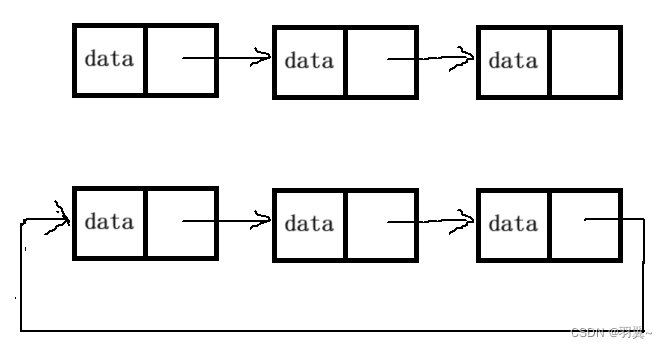
链表有很多,重点掌握两种:
无头单向非循环链表:结构简单,一般不会单独用来存数据。实际中更多是作为其他数据结构的子结构,如哈希桶、图的邻接表等等。另外这种结构在笔试面试中出现很多

无头双向链表:在Java的集合框架库中LinkedList底层实现就是无头双向循环链表。
2.2 链表的实现
//无头单向非循环链表实现
public class SingleLinkedList {
//头插法
public void addFirst(int data){
}//尾插法
public void addLast(int data){
}//任意位置插入,第一个数据节点为0号下标
public void addIndex(int index,int data){
}//查找是否包含关键字key是否在单链表当中
public boolean contains(int key){
return false;
}//删除第一次出现关键字为key的节点
public void remove(int key){
}//删除所有值为key的节点
public void removeAllKey(int key){
}//得到单链表的长度
public int size(){
return -1;
}//清空
public void clear() {
}//打印
public void display() {
}
}
三、链表面试题
3.1 删除链表中所有值为val的节点
删除链表中等于给定值val的所有节点 链接
public class ListNode {
int val;
ListNode next;
ListNode() {} ;
ListNode(int val) {
this.val = val;
}
ListNode(int val, ListNode next) {
this.val = val;
this.next = next;
}
}
解法1:遍历整个链表,将其中值为val的节点删除(将要删除节点前的节点的next指向要删除节点后的第一个节点)。

public ListNode removeElements(ListNode head, int val) {
//原链表是空链表
if(head==null)
return head;
ListNode cur=head;
//从第二个节点判断
while(cur.next!=null){
//下一个节点的值
if(cur.next.val==val){
cur.next=cur.next.next;
}
else{
cur=cur.next;
}
}
//判断头节点
if(head.val==val){
head=head.next;
}
return head;
}
解法2:遍历整个链表,将所有值不是给定值val的节点放入新链表中,返回新链表。

public ListNode removeElements(ListNode head, int val) {
//原链表是空链表
if(head==null)
return head;
//新链表的头节点
ListNode head1=new ListNode();
//新链表的节点
ListNode cur1=head1;
//原来链表的节点
ListNode cur=head;
//遍历原来链表
while(cur!=null){
//当前节点的值
if(cur.val==val)
cur=cur.next;
else{
cur1.next=cur;
cur=cur.next;
cur1=cur1.next;
}
}
//如果新链表的尾节点不是原来链表的尾节点,将next置空
if(cur1.next!=null)
cur1.next=null;
return head1.next;
}
3.2 反转一个单链表
链接

public class ListNode {
int val;
ListNode next;
ListNode() {}
ListNode(int val) {
this.val = val;
}
ListNode(int val, ListNode next) {
this.val = val;
this.next = next;
}
}
public ListNode reverseList(ListNode head) {
//原链表为空
if(head==null)
return null;
//原链表只有一个节点
if(head.next==null)
return head;
//原链表的第二个节点开始
ListNode cur=head.next;
head.next=null;
//遍历链表
while(cur!=null){
//curNext为当前节点的下一个节点
ListNode curNext=cur.next;
//头插法插入节点
cur.next=head;
head=cur;
//当前节点指向原链表位置的下一个节点
cur=curNext;
}
return head;
}
3.3 链表的中间节点
给一个带有头结点 head 的非空单链表,返回链表的中间结点。如果有两个中间结点,则返回第二个中间结点 链接
public class ListNode {
int val;
ListNode next;
ListNode() {}
ListNode(int val) {
this.val = val;
}
ListNode(int val, ListNode next) {
this.val = val;
this.next = next;
}
}
解法1:先求链表长度,获取长度一半的节点

public ListNode middleNode(ListNode head) {
ListNode cur=head;
//链表的长度
int count=0;
while(cur!=null){
cur=cur.next;
count++;
}
int BinaCount=count/2;
ListNode ret=head;
for(int i=0;i<BinaCount;i++){
ret=ret.next;
}
return ret;
}
缺陷:需要两次遍历才能找到中间节点,当节点较多时,时间复杂度较大。
解法2:在一次遍历中找到中间节点,两个引用fast和slow分别走两步和一步
public ListNode middleNode(ListNode head) {
ListNode fast=head;
ListNode slow=head;
while(fast!=null&&fast.next!=null){
fast=fast.next.next;
slow=slow.next;
}
return slow;
}
3.4 将有序链表合并
将两个有序链表合并为一个新的有序链表并返回。新链表是通过拼接给定的两个链表的所有节点组成的 链接
public class ListNode {
int val;
ListNode next;
ListNode() {}
ListNode(int val) {
this.val = val;
}
ListNode(int val, ListNode next) {
this.val = val;
this.next = next;
}
}

public ListNode mergeTwoLists(ListNode list1, ListNode list2) {
ListNode NewHead=new ListNode();
//Newcur 新链表的尾节点
ListNode Newcur=NewHead;
while(list1!=null&&list2!=null){
if(list1.val<list2.val){
Newcur.next=list1;
list1=list1.next;
}else{
Newcur.next=list2;
list2=list2.next;
}
Newcur=Newcur.next;
}
//list1还有数
if(list1!=null){
Newcur.next=list1;
}
//list2还有数
if(list2!=null){
Newcur.next=list2;
}
return NewHead.next;
}
3.5 输出倒数第k个节点
输入一个链表,输出该链表中倒数第k个结点 链接
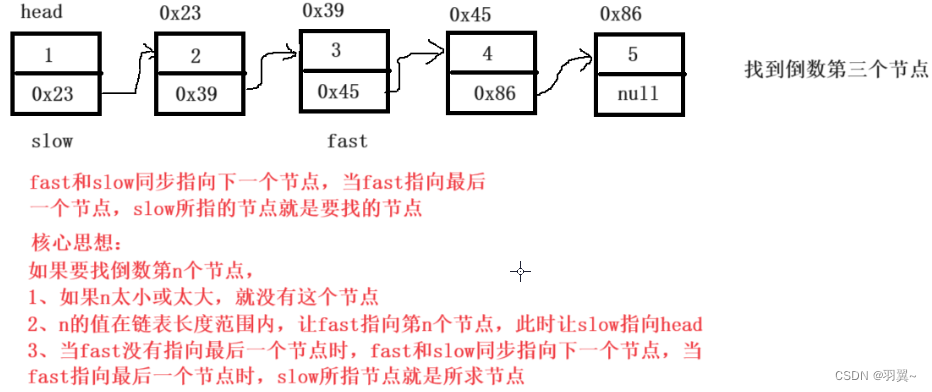
public ListNode FindKthToTail(ListNode head,int k) {
//链表为空或k太小
if(k<=0||head==null){
return null;
}
ListNode fast=head;
//fast指向第k个节点
while(k>1){
fast=fast.next;
//当k太大
if(fast==null){
return null;
}
k--;
}
ListNode slow=head;
//fast没有指向最后一个节点
while(fast.next!=null){
fast=fast.next;
slow=slow.next;
}
return slow;
}
3.6 链表分割
编写代码,以给定值x为基准将链表分割成两部分,所有小于x的结点排在大于或等于x的结点之前 链接
public class ListNode {
int val;
ListNode next = null;
ListNode(int val) {
this.val = val;
}
}

public ListNode partition(ListNode pHead, int x) {
//pmin链表存小于x的节点
ListNode pmin = null;
//pin为pmin的尾节点
ListNode pin = null;
//pmin链表存大于等于x的节点
ListNode pmax = null;
//pax为pmax的尾节点
ListNode pax = null;
//遍历链表pHead,将小于x和大于等于x的存入pmin和pmax中
ListNode cur = pHead;
while (cur != null) {
if (cur.val < x) {
if (pmin == null) {
//pmin为空
pmin = cur;
pin = cur;
} else {
//pmin不为空
pin.next = cur;
pin = pin.next;
}
} else {
if (pmax == null) {
//pmax为空
pmax = cur;
pax = cur;
} else {
//pmax不为空
pax.next = cur;
pax = pax.next;
}
}
cur = cur.next;
}
if(pmin==null){
//没有小于x的
return pmax;
}
if(pmax==null){
//没有大于等于x的return pmin;
}
//将pmin与pmax串联起来(pmin的尾节点指向pmax的头节点)
pin.next=pmax;
if(pax.next!=null){
pax.next=null;
}
return pmin;
}
3.7 链表的回文结构
链接
public class ListNode {
int val;
ListNode next = null;
ListNode(int val) {
this.val = val;
}
}
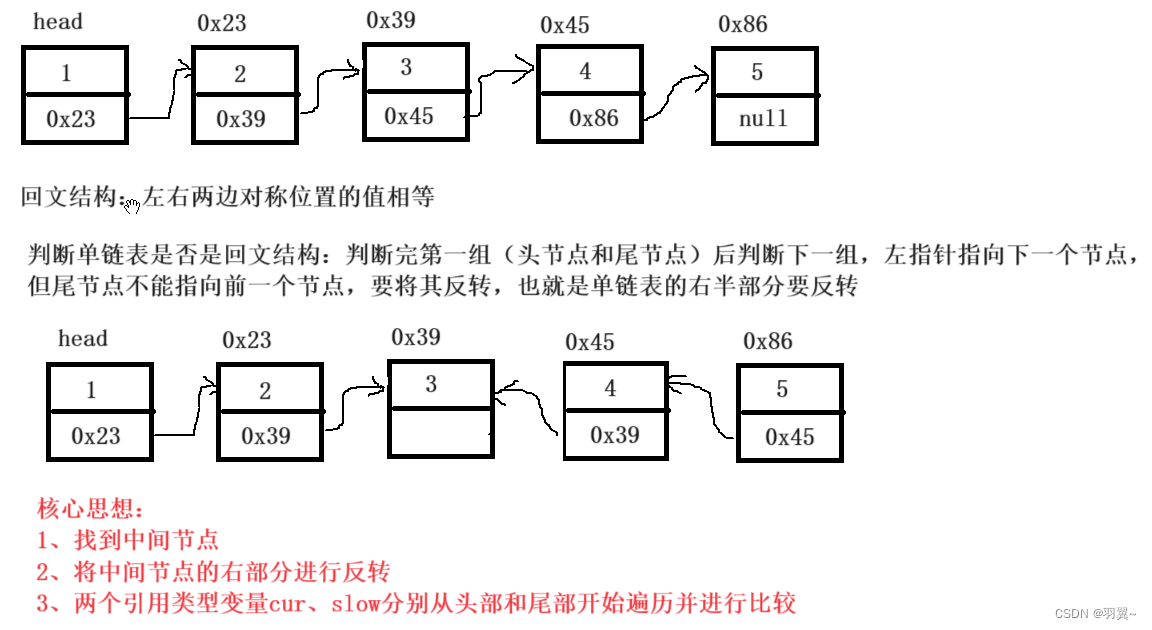
反转:
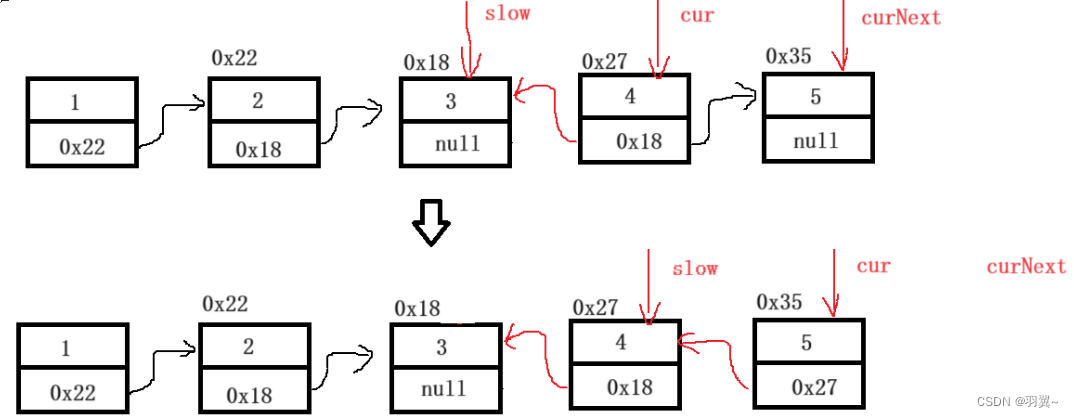
public boolean chkPalindrome(ListNode A) {
ListNode fast = A;
//1、找中间节点slow
ListNode slow = A;
while (fast != null && fast.next != null) {
fast = fast.next.next;
slow = slow.next;
}
//2、中间节点之后的反转
//cur是节点后的第一个节点
ListNode cur = slow.next;
slow.next=null;
while (cur!= null) {
//保存cur后的第一个节点
ListNode curNext = cur.next;
cur.next = slow;
slow = cur;
cur = curNext;
}
//反转结束后,slow指向最后一个节点
//3、从第一个节点开始判断
cur = A;
while (cur != slow && cur.next != slow) {
if (cur.val != slow.val) {
return false;
} else {
cur = cur.next;
slow = slow.next;
}
}
return true;
}
3.8 找两个链表的公共节点
输入两个链表,找出它们的第一个公共结点 链接
public class ListNode {
int val;
ListNode next;
ListNode(int x) {
val = x;
next = null;
}
}

public ListNode getIntersectionNode(ListNode headA, ListNode headB) {
//lenA、lenB分别为链表headA和链表headB的长度
int lenA = 0;
int lenB = 0;
ListNode curA = headA;
ListNode curB = headB;
while(curA != null){
lenA++;
curA = curA.next;
}
while( curB != null){
lenB++;
curB = curB.next;
}
//pl指向最长链表,ps指向最短链表
ListNode pl = headA;
ListNode ps = headB;
//长度差值len
int len = lenA-lenB;
if(len<0){
//修正pl、ps、len
pl = headB;
ps = headA;
len = lenB-lenA;
}
//pl走差值步
while(len>0){
pl = pl.next;
len--;
}
//同步走
while(pl != ps){
pl = pl.next;
ps = ps.next;
}
//pl为空,没有公共节点
if(pl == null){
return null;
}
return pl;
}
3.9 判断链表是否有环
给定一个链表,判断链表中是否有环 链接

class ListNode {
int val;
ListNode next;
ListNode(int x) {
val = x;
next = null;
}
}
public boolean hasCycle(ListNode head) {
//快慢指针
ListNode fast = head;
ListNode slow = head;
while(fast!=null&&fast.next!=null){
fast=fast.next.next;
slow=slow.next;
//相遇->有环
if(fast==slow){
return true;
}
}
//循环结束->无环
return false;
}
3.10 找链表入环的第一个节点
给定一个链表,返回链表开始入环的第一个节点, 如果链表无环,则返回 NULL 链接
class ListNode {
int val;
ListNode next;
ListNode(int x) {
val = x;
next = null;
}
}


public ListNode detectCycle(ListNode head) {
//快慢指针
ListNode fast=head;
ListNode slow=head;
//找相遇节点
while(fast!=null&&fast.next!=null){
fast=fast.next.next;
slow=slow.next;
//相遇
if(fast==slow){
break;
}
}
//fast=null或fast.next=bull->链表不为环,也就没有入环的第一个节点
if(fast==null||fast.next==null){
return null;
}
//慢指针从头开始
slow=head;
while(slow!=fast){
slow=slow.next;
fast=fast.next;
}
//循环结束,slow和fast都指向入环的第一个节点
return slow;
}
结论:让一个指针从链表起始位置开始走,同时让一个指针从判环时相遇点的位置开始走,两个指针每次均走一步,最终肯定会在环的入口点的位置相遇。
四、LinkedList的模拟实现
无头双向链表实现public class MyLinkedList {//头插法public void addFirst(int data){ }//尾插法public void addLast(int data){}//任意位置插入,第一个数据节点为0号下标public void addIndex(int index,int data){}//查找是否包含关键字key是否在单链表当中public boolean contains(int key){}//删除第一次出现关键字为key的节点public void remove(int key){}//删除所有值为key的节点public void removeAllKey(int key){}//得到单链表的长度public int size(){}//打印链表public void display (){}//清空链表public void clear (){}}
//无头双向链表的操作 public interface IOPeration {//头插法public void addFirst(int data);//尾插法public void addLast(int data);//任意位置插入,第一个数据节点为0号下标public boolean addIndex(int index,int data);//查找是否包含关键字key是否在单链表当中public boolean contains(int key);//删除第一次出现关键字为key的节点public void remove(int key);//删除所有值为key的节点public void removeAllKey(int key);//得到单链表的长度public int size();//打印链表public void display();//清空链表public void clear(); }
public class MySidesLinkList implements IOPeration{static class ListNode {int val;ListNode pre;ListNode next;public ListNode(int data){val=data;}}private int usedSize;private ListNode head;private ListNode last;@Overridepublic void addFirst(int data) {ListNode node = new ListNode(data);if(head == null){head = node;last = node;}else {node.next = head;head.pre = node;head = node;}usedSize++;}@Overridepublic void addLast(int data) {ListNode node = new ListNode(data);if(last == null){head = node;last = node;}else {last.next = node;node.pre = last;last = node;}usedSize++;}@Overridepublic boolean addIndex(int index, int data) {if(index<0||index>usedSize){throw new IndexEception("下标异常:"+index);}if(index == 0){addFirst(data);return true;}if(index == usedSize){addLast(data);return true;}ListNode cur=head;while(index>0){cur = cur.next;index--;}ListNode node = new ListNode(data);cur.pre.next = node;node.next=cur;node.pre = cur.pre;cur.pre = node;usedSize++;return true;}@Overridepublic boolean contains(int key) {ListNode cur = head;while(cur != null){if(cur.val == key){return true;}else {cur=cur.next;}}return false;}@Overridepublic void remove(int key) {ListNode cur = head;while(cur != null){if(cur.val == key){if(cur == head){head = head.next;head.pre = null;cur.next = null;}else if(cur == last){last = last.pre;last.next = null;cur.pre = null;}else {cur.pre.next = cur.next;cur.next.pre = cur.pre;}usedSize--;return;}else {cur = cur.next;}}}@Overridepublic void removeAllKey(int key) {ListNode cur = head;while(cur != null){if(cur.val == key){ListNode curNext=cur.next;if(cur == head){head = head.next;head.pre = null;cur.next = null;}else if(cur == last){last = last.pre;last.next = null;cur.pre = null;}else {cur.pre.next = cur.next;cur.next.pre = cur.pre;}usedSize--;cur=curNext;}else {cur = cur.next;}}}@Overridepublic int size() {return usedSize;}@Overridepublic void display() {ListNode cur = head;while (cur != null){System.out.print(cur.val+" ");cur = cur.next;}System.out.println();}@Overridepublic void clear() {ListNode cur = head;while (cur != null){ListNode curNext = cur.next;cur.pre = null;cur.next = null;cur=curNext;}head = null;last = null;}
}
//下标异常类
public class IndexEception extends RuntimeException{public IndexEception (String massage){super(massage);}
}
五、LinkedList的使用
5.1 什么是LinkedList
LinkedList的底层是双向链表结构,链表没有将元素存储在连续空间中,而是存储在单独的节 点中,通过引用将节点连接起来了,因此在任意位置插入或者删除元素时,不需要搬移元素,效率较高。
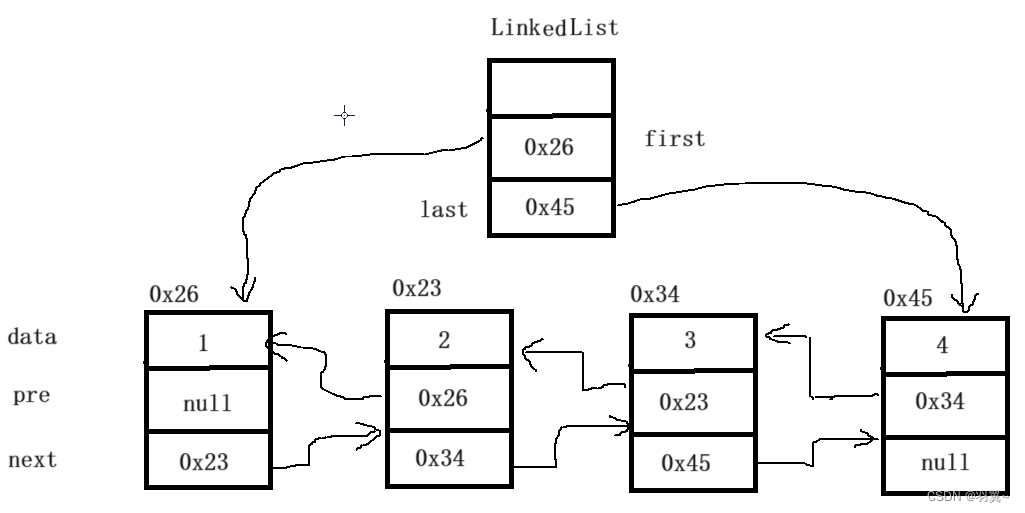
在集合框架中,LinkedList也实现了List接口:
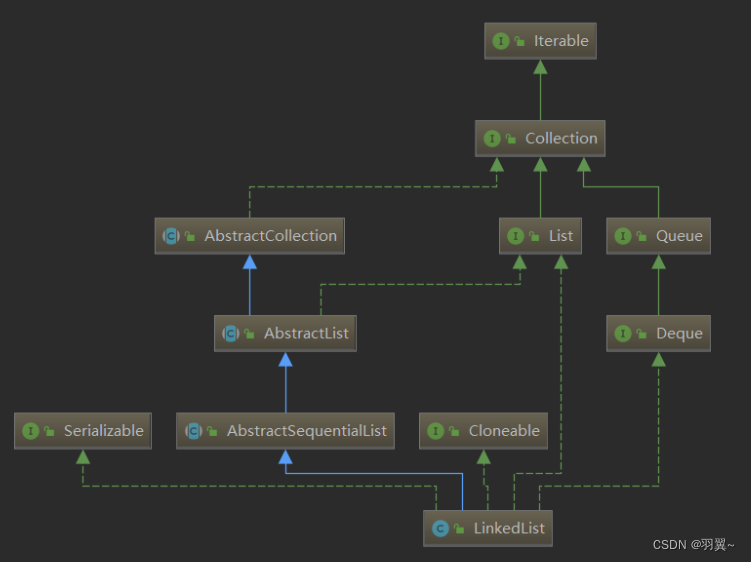
LinkedList实现了List接口,底层使用双向链表;没有实现RandomAccess接口,不支持随机访问;LinkedList在任意位置插入和删除效率较高,时间复杂度为O(1);适合任意位置插入的场景。
5.2 LinkedList的使用
1. LinkedList的构造
| 方法 | 解释 |
| public LinkedList(); | 无参构造 |
| public LinkedList(Collection<? extends E> c) | 使用其他集合容器中元素构造List |
public static void main(String[] args) {LinkedList<Integer> list1 = new LinkedList<>();list1.addLast(1);list1.addLast(2);list1.addLast(3);//打印链表for (Integer x:list1) {System.out.print(x+" ");}System.out.println();/*使用list1中的元素构造list2* 其中list1的类型是与list2是同类型或是list2的子类类型* 存储元素的类型保持一致*/LinkedList<Integer> list2 = new LinkedList<>(list1);//打印链表for (Integer x:list2) {System.out.print(x+" ");}System.out.println();
}
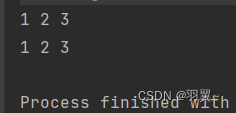
2. LinkedList其他常用方法
| 方法 | 解释 |
| boolean add(E e) | 尾插 e |
| void add(int index, E element) | 将 e 插入到 index 位置 |
| boolean addAll(Collection<? extends E> c) | 尾插 c 中的元素 |
| E remove(int index) | 删除 index 位置元素 |
| boolean remove(Object o) | 删除第一个 o |
| E get(int index) | 获取下标 index 位置元素 |
| E set(int index, E element) | 将下标 index 位置 元素设置为 element |
| void clear() | 清空 |
| boolean contains(Object o) | 判断 o 是否在链表中 |
| int indexOf(Object o) | 返回第一个 o 所在下标 |
| int lastIndexOf (Object o) | 返回最后一个 o 的下标 |
| List<E> subList(int fromIndex, int toIndex) | 截取部分 list |
public static void main(String[] args) {LinkedList<Integer> list = new LinkedList<>();list.add(1);//尾插list.add(2);list.add(3);list.add(4);list.add(5);System.out.println(list.size()); //5System.out.println(list); //[1, 2, 3, 4, 5]System.out.println("====");list.add(2,10);//在 index 位置插入元素list.addFirst(10);//头插list.addLast(10);//尾插System.out.println(list); //[10, 1, 2, 10, 3, 4, 5, 10]System.out.println("====");list.remove();//默认删除第一个元素System.out.println(list); //[1, 2, 10, 3, 4, 5, 10]list.removeFirst();//删除第一个元素System.out.println(list); //[2, 10, 3, 4, 5, 10]list.removeLast();//删除最后一个元素System.out.println(list); //[2, 10, 3, 4, 5]list.remove(1);//删除index位置的元素System.out.println(list); //[2, 3, 4, 5]System.out.println("====");//contains(elem)判断elem元素是否存在System.out.println(list.contains(5));//true//从前向后找第一个elem出现的位置System.out.println(list.indexOf(3));//从后向前找第一个elem出现的位置System.out.println(list.lastIndexOf(4));System.out.println("====");//获取index位置的元素int elem = list.get(0);//set设置index位置的值为elemlist.set(0,100);System.out.println(list); //[100, 3, 4, 5]System.out.println("====");//subList截取部分(左闭右开)并返回,返回值类型为List<E>List<Integer> list2 = list.subList(0,2);System.out.println(list2); //[100, 3]
}
3. LinkedList的遍历
public static void main(String[] args) {LinkedList<Integer> list = new LinkedList<>();list.add(1);list.add(2);list.add(3);list.add(4);list.add(5);//遍历链表//foreach遍历for (int x:list) {System.out.print(x+" ");//1 2 3 4 5}System.out.println();//迭代器遍历ListIterator<Integer> it = list.listIterator();while (it.hasNext()){System.out.print(it.next()+" ");//1 2 3 4 5}System.out.println();//反向迭代器遍历ListIterator<Integer> reverseIt = list.listIterator(list.size());while (reverseIt.hasPrevious()){System.out.print(reverseIt.previous()+" ");//5 4 3 2 1 }
}
六、ArrayList和LinkedList的区别
| 不同点 | ArrayList | LinkedList |
| 存储空间上 | 物理上一定连续 | 逻辑上连续,但物理上不一定连续 |
| 随机访问 | 支持O(1) | 不支持O(N) |
| 头插 | 需要移动元素,效率低O(N) | 只需修改引用的指向,O(1) |
| 插入 | 空间不够需要扩容 | 没有容量的概念 |
| 应用场景 | 元素高效存储、频繁访问 | 任意位置插入和删除频繁 |


